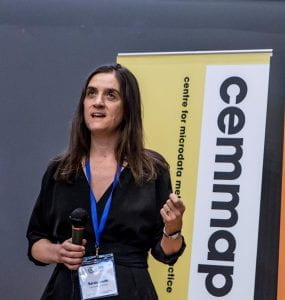 Professor Sarah Smith, Head of Economics at University of Bristol explores the stereotypes within the industry in her article, ‘What does an economist look like?’
Professor Sarah Smith, Head of Economics at University of Bristol explores the stereotypes within the industry in her article, ‘What does an economist look like?’
Ask google, or, as I have been doing, 15-17 year olds and you get pretty much the same answer. An economist is someone who is middle-aged, wearing a suit and a tie, with pound or dollar signs floating before their eyes. And – the tie gives it away – an economist is almost certainly a man.
The lack of women in economics is everywhere – from a procession of (all but one) male Nobel prize winners until this year’s award to Esther Duflo, to the monetary policy committee (nine members, one woman) to economics departments (one in five professors) and down into economics classrooms (fewer than one in three economics undergraduate and A level students). STEM subjects have made huge progress in recent years and economics now lags behind maths, chemistry and biology in its ability to attract female students. This pipeline problem is worrying for the future of the subject.
Economics’ image problem and its diversity problem go hand-in-hand. That’s why, five months ago, I co-launched a national campaign to promote greater diversity among economics students by giving 15-17 year olds information and opportunities to find out what an economics degree might be like and where it might lead.
Discover Economics
The campaign, Discover Economics came from a belief that many 15-17 year olds were making choices about what to study based on a very narrow view of economics. The subject isn’t taught in all schools and is not a compulsory part of the curriculum so students may have little more than a vague notion that it’s got something to do with money – and that you will end up wearing a suit and tie.
We now have a website, run outreach events and are planning a student ambassador programme. We launched the campaign with several founding partners (the Bank of England, NIESR, Resolution Foundation, Economy, McKinsey and Company, IFS, University of Warwick, Frontier Economics….). We received a lot of early media attention and were nominated for a CityAM diversity award. We are now looking for funding to scale up activities. Women are not the only target for the campaign – we also want to attract more students from state school and colleges and from minority groups – but the gender dimension is an important one.
There are many reasons to want to attract more women to study economics. Diversity is key for intellectual development and innovation and is the only way to ensure that economics draws on the widest possible range of ideas. Male and female economists are interested in different topics – they even hold different views on key issues such as the efficacy of government intervention and whether or not the labour market is fair. Economists occupy key positions of influence in government – they advise on everything from healthcare to climate change policy to the shape of post-Brexit Britain. They get to shape the society we live in. Economics is just too important to be left to half the population.
Find out more about Discover Economics.

